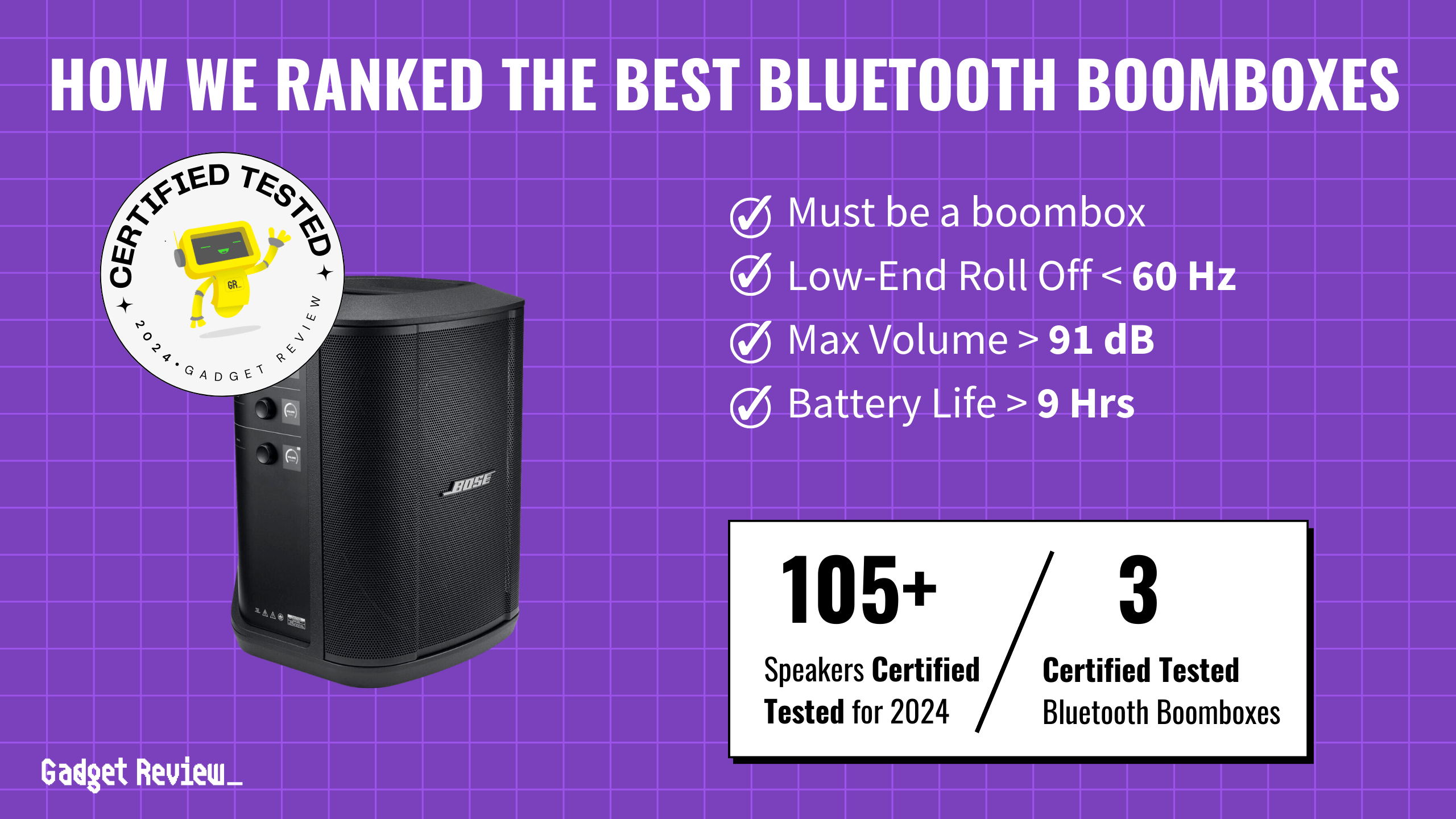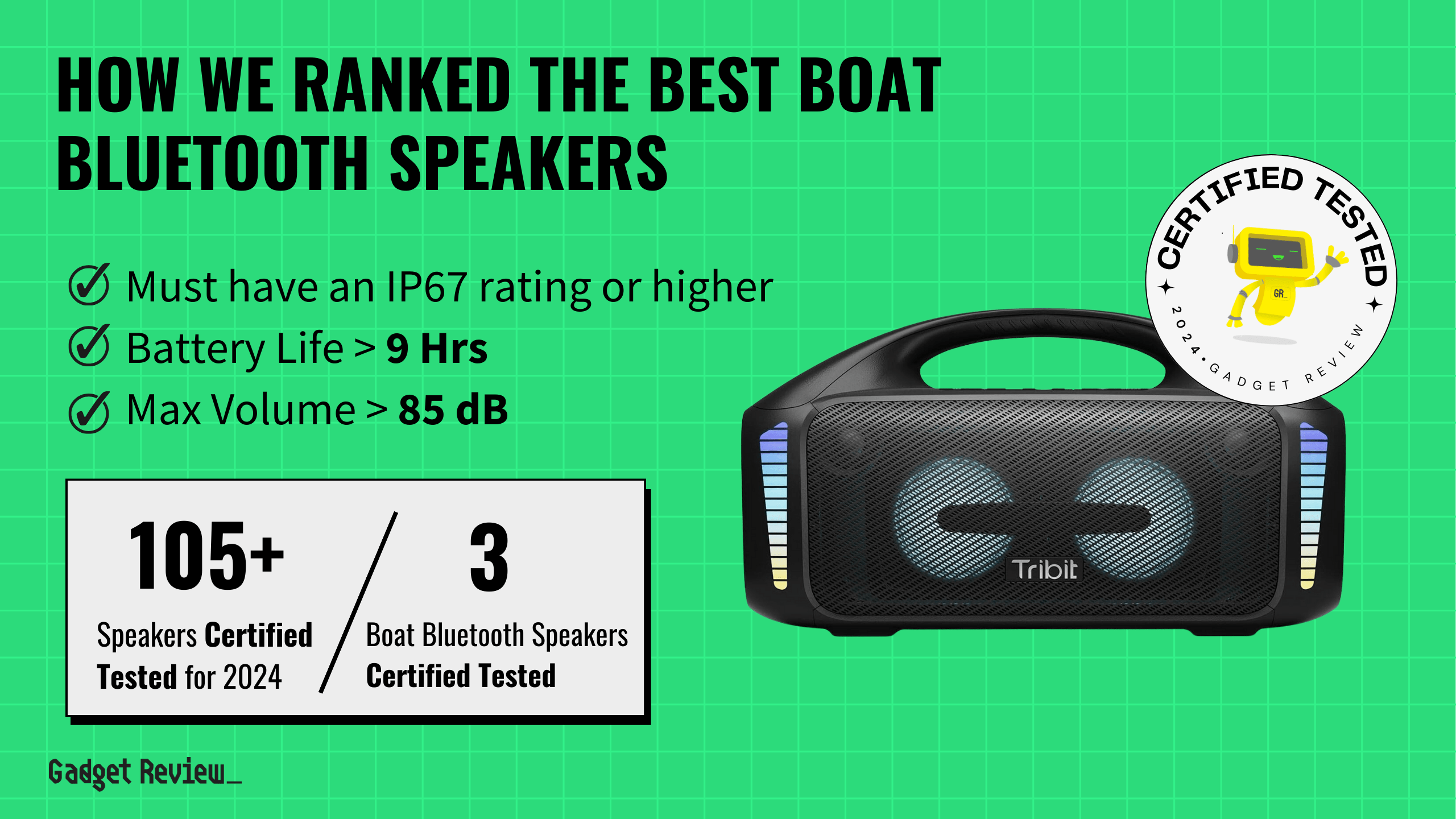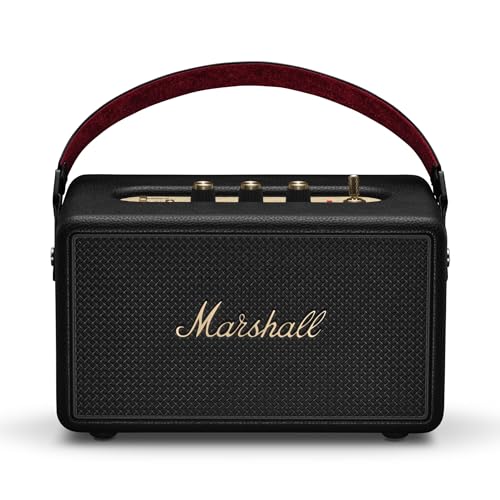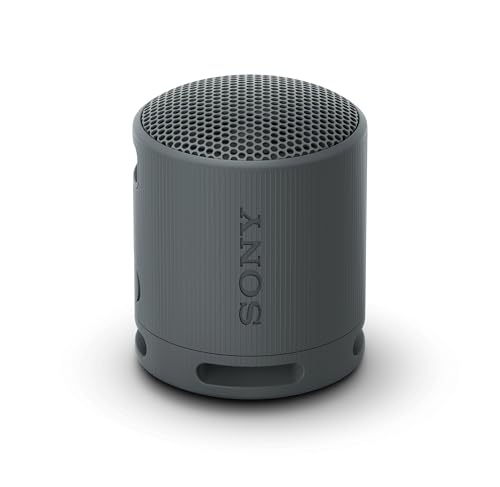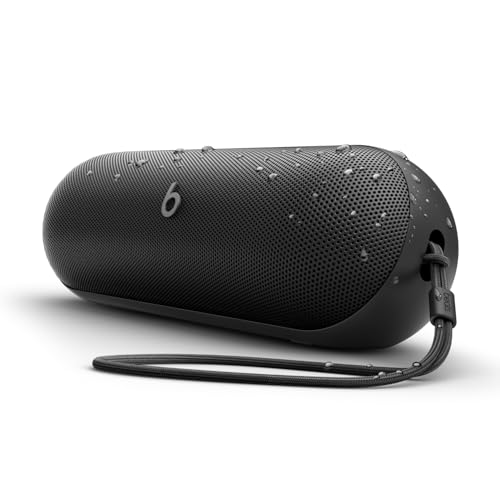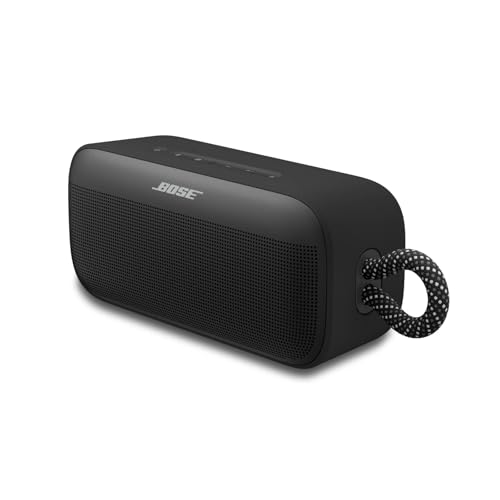What features make for the best wireless surround sound system? Whether you’re looking for a true surround sound setup featuring a wireless connection between the individual front and rear speakers, or a simple, fully wireless soundbar, it starts with great sound quality. Next, the best surround sound wireless speakers should be compatible with your audio format. Keep in mind that these systems tend to use Wi-Fi connectivity versus the top-rated Bluetooth speakers. Finally, the best wireless surround speakers should have strong wireless connectivity to ensure smooth, HD audio playback on all the separate speakers.
These features make a wireless surround sound system a phenomenal choice if you’re looking for a more immersive listening experience without drilling holes for audio cables. It also helps create a clean-looking home cinema.
Keep reading to learn more about the best wireless surround sound systems and how to choose the best speakers for your audio needs.
Top Wireless Surround Sound Speakers
#1 JBL Bar 9.1 Speakers
Award: TOP PICK
WHY WE LIKE IT: This powerful system packs in a serious punch, coming complete with ultra HD 4K pass-through. You’ll also appreciate including a remote control for a more effortless experience and its wireless capabilities.
- Wireless experience
- Ultra HD 4K pass-through
- Includes remote control
- Might have some bugs
The power that this speaker system can pull is absolutely astounding, as is the audio that results from it. It has built-in Dolby Atmos technology, allowing it to bring theater-style sound to your living room. This means you’ll be able to enjoy movies with life-like sounds. Unfortunately, this sound system is known for having a few different bugs that might cause a problem. This will require you to troubleshoot the system and might be a dealbreaker.
This is a battery-powered option, which makes it highly convenient. You won’t have to mess around with many wires for it to work. It also has detachable speakers on either end of the soundbar for better audio placement. That means you can get the crisp, clear sound right where you need it. It produces deep bass thanks to the 10” powered subwoofer. This speaker system can pull 300 watts of power, making it a high-powered option for your living room.
#2 VIZIO M-Series M51ax-J6 Speakers
Award: HONORABLE MENTION
WHY WE LIKE IT: You won’t have a huge hassle on your hands when you choose this system because it’s so easy to set up. It also boasts a low-profile design that’s entirely modern and chic. You’ll love the fully immersive experience it delivers.
- Fully immersive experience
- Low-profile design
- Extremely easy set-up
- Might need consistent resets
The low-profile design of this speaker system means that it will be at home regardless of the decor in the room. It has a clean silhouette and a matte finish, and subtle texturing. This is a gorgeous soundbar that you’ll be proud to display. However, some consumers have reported that they are unhappy with how often they have to reset this speaker system. That might be a dealbreaker due to lower convenience.
You’ll appreciate the immersive audio that it produces thanks to the Dolby Audio 5.1 technology built into it. This will compliment all of your 4K HDR content, making all audio sound so much better. The system is capable of producing floor-to-ceiling immersive audio that will captivate the audience. The brand includes a backlit remote that is easy to use and has a comfortable grip. This makes controlling your audio system far easier.
#3 Polk Audio Signa S4 Speaker
Award: BEST FOR LOW-PROFILE DESIGN
WHY WE LIKE IT: This multifunctional model should work with just about any television you want to hook it up to. It’s also highly slender, easily fitting into any environment or space. You’ll appreciate the life-like audio production.
- Super slender design
- Life-like audio production
- Multifunctional model
- Remote might be annoying
If you’re looking for an ultra-slim option capable of producing near-perfect audio, this will be an excellent fit for you. It has VoiceAdjust technology, which allows you to hear every word in your audio. This patented technology will enable you to raise the volume only for voices. There are some reports that this model’s remote control is a little annoying to use. This is primarily due to the material used for the buttons and their push-back.
This model is also Dolby Atmos-certified, immersing you in a 360-degree range of sound. The soundbar can provide an authentic 3D experience, unlike many competing models that lack the same technology. This adds ambiance to your music, enhances special effects, and incredibly realistic sound replication. There are three different modes included, which allow for fully customizable sound. You’ll have access to movies, music, and night mode when choosing this soundbar.
#4 Wohome Model S99 Speaker
Award: BEST FOR DEEP BASS
WHY WE LIKE IT: If you’re looking for an experience free of messy wires, this is a great option to fulfill those needs. It also offers multiple different options for connections so you can ensure setup is easy. This model has a 2.1ch sound.
- Non-wired connectivity
- Multiple connection options
- Features 2.1ch sound
- Might sound a little muffled
Anybody who’s looking for fantastic bass will find it in this soundbar. You’ll enjoy the crystal clear sound that it can produce, especially the deep bass. This bass is created using a powerful subwoofer included in the design of this model. However, it is essential to note that some consumers report that the subwoofer sounds a little bit “muffled.” This can impact your overall experience, so looking elsewhere might be a sign.
This is an excellent system for those who want 3D surround sound. It has loud volume settings, so you can have an entirely immersive experience. It also produces deep, satisfying bass thanks to the 5.5-inch subwoofer that this system comes with. You’ll love that this system makes delicate treble notes for higher-pitched sounds. The DSP technology ensures that dialogue will be easy to hear and that you can clearly hear the details in the audio.
#5 RIOWOIS Sound Bar Speaker
Award: BEST FOR VIDEO GAMES
WHY WE LIKE IT: You’ll be pleased with this system if you’re a person who loves gaming. It has three different sound modes, so you can easily get the best audio. This option also offers multiple connectivity options and an easy setup.
- Three sound modes
- Simple connectivity
- Extremely easy setup
- Might be too quiet
This system is excellent for anybody that loves to play video games. The package includes a soundbar, as well as a separate subwoofer. This means that you’ll be able to have a more immersive audio experience than with competing models that don’t include the subwoofer. Unfortunately, some consumers report that this speaker system was a little too quiet for them. This might not be the best model if you need booming sound to be happy.
The full-range upgraded drivers are why this unit can produce completely clear audio with incredible voice clarity. You’ll be able to connect through a full range of different options. This includes Bluetooth wireless, auxiliary cords, coax cables, and more. The LED indicator will change colors to let you know the status of your sound system. The vertical surround engine creates stunning 3D audio that will have you totally sucked into the game.
#6 Nakamichi Shockwafe Ultra Speaker
Award: BEST FOR EASY INSTALLATION
WHY WE LIKE IT: You’ll thoroughly enjoy the deep, booming audio that this system can produce. It’s a luxury-level model that will ensure you can enjoy theater-quality entertainment in the comfort of your home.
- Extremely deep sound
- Luxury-level performance
- Theater quality audio
- Not very budget-friendly
If you’re looking for a truly magical, cinema-like experience, this option is exactly what you need. It’s a speaker system that is built to deliver powerful audio, just like you hear at the movies. The 360-degree surround sound will impress and delight anybody who experiences it. However, you’ll be investing quite a bit of funding into this speaker system. Since it’s a luxury-level system, it’s not exactly the most budget-friendly option available.
You’ll love how deep the bass is that the subwoofers are capable of producing. They have a 10” speaker driver packed in so that they can provide rich, booming sound to your living room. The reason the brand offers two is that movie theaters use multiple subwoofers. This means you’re able to achieve a truly cinematic experience from the comfort of your own home. The life-like sound is impressive since this system includes four surround speakers.

DON’T SEE WHAT YOU’RE LOOKING FOR?
Looking for more options beyond wireless surround sound systems? Consider exploring top-rated alternatives like the best golf cart Bluetooth speakers, ideal for on-the-go entertainment, or the immersive sound experience of the best boat Bluetooth speaker. For DJ enthusiasts, explore the power and clarity of the best DJ speakers or dive into the rich sound quality of the best bookshelf speakers. Discover these and more options that cater to your specific audio needs.
Beginner’s Guide to Wireless Surround Sound
What Is Wireless Surround Sound?
Looking for the best wireless surround sound system? Keep reading, as our guide talks about the pros and cons of good and great wireless sound systems, and how to get the right one for you.
Wireless surround sound refers to multi-channel audio systems that use one or more wireless speakers to achieve an immersive experience in your home cinema. A wireless, high-end surround sound system may or may not be completely wireless. It can use multiple wireless speakers, a wireless subwoofer, and a center speaker that connects to a TV or other device via an optical input or other input, like an HDMI ARC wired connection.
In short, the best wireless speakers for home theater setups can be a combination of wireless and wired connections, depending on the model you buy. But, most wireless home Hi-Fi systems will usually connect over a Wi-Fi network. Many wireless home theater systems and a few years earlier, enable voice control and come with companion apps, smart TV compatibility, and smart home integration.
Wireless Surround Sound vs Speakers in General
Compared to speakers in general, wireless surround sound systems are more complex and deliver high-quality audio through multiple directional channels. This is what makes high-end wireless surround sound systems for a TV most popular among consumers.
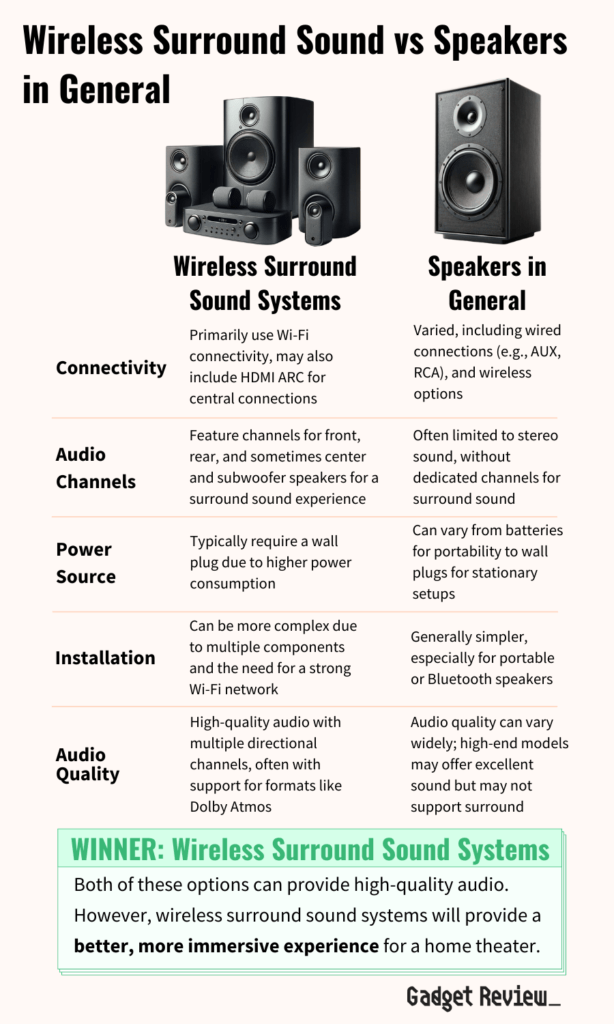
| Feature | Wireless Surround Sound Systems | Speakers in General |
|---|---|---|
| Connectivity | Primarily use Wi-Fi connectivity, may also include HDMI ARC for central connections | Varied, including wired connections (e.g., AUX, RCA), and wireless options |
| Audio Channels | Feature channels for front, rear, and sometimes center and subwoofer speakers for a surround sound experience | Often limited to stereo sound, without dedicated channels for surround sound |
| Power Source | Typically require a wall plug due to higher power consumption | Can vary from batteries for portability to wall plugs for stationary setups |
| Installation | Can be more complex due to multiple components and the need for a strong Wi-Fi network | Generally simpler, especially for portable or Bluetooth speakers |
| Audio Quality | High-quality audio with multiple directional channels, often with support for formats like Dolby Atmos | Audio quality can vary widely; high-end models may offer excellent sound but may not support surround |
| Smart Features | Often include smart remote controls, compatibility with smart home devices, and voice command systems | Smart features are less common, especially in basic models |
| Portability | Less portable due to reliance on Wi-Fi and power sources | Ranges from highly portable Bluetooth speakers to stationary bookshelf and floor-standing models |
| Multi-Device Connectivity | Designed to connect to multiple devices simultaneously, enhancing the home theater experience | May or may not support multi-device connectivity, depending on the model |
| Setup and Configuration | Initial setup via smartphone apps or smart TV, with potential for complex configurations | Setup tends to be straightforward, often involving simple pairing or plug-and-play connections |
| Ideal Use | Best for immersive home cinema experiences, multi-room audio systems, and integrated smart home setups | Wide range of uses, from personal listening to parties, depending on the speaker type and features |
Unlike bookshelf speakers and individual monitor speakers, great wireless sound systems for a TV feature channels for front and rear speakers. As the name implies, a wireless surround sound system uses one or more wireless units. Unlike most Bluetooth speakers, these systems use Wi-Fi connectivity and can connect to multiple devices.
Unlike truly portable Bluetooth speaker units and the marine speakers for outdoor use, Wi-Fi systems for home theaters often require a wall plug. If you’re using a power source that’s not a wall outlet for any wireless speakers for home theater systems, you’re risking electrical problems and shorting out your fine wireless home theater setup. Some units use an HDMI ARC connection to your smart TV or 4K Blu-Ray player and a wireless connection among individual speakers. Ultimately, the goal is to have a strong power source and the right connections to effectively use a top-tier wireless home theater system.
Like other types of speakers, the sound quality and audio fidelity of a wireless surround sound system depend on each speaker’s quality, size, output power, and how the speaker layout interacts with the acoustic properties of the room. Unlike wired Hi-Fi systems, a wireless setup requires a strong Wi-Fi network for the best audio experience.
A wireless surround sound system is more likely to feature a smart remote control, smart home compatibility, and built-in support for voice command systems, Google Assistant, Google Home, and other IoT interfaces. Conversely, most wireless wall speakers aren’t as powerful as their wired counterparts.
How Wireless Surround Sound Systems Work
Most wireless surround sound system speakers aren’t completely wireless but use a wired HDMI ARC out or audio cables to connect a center speaker to a device such as a smart TV, computer, games console, or 4K Blu-Ray player. The center channel speaker then connects wirelessly to any extra speakers using a WiFi connection. A few models, however, are entirely wireless. These systems dispense with speaker wires entirely, using WiFi to connect all the speakers to the output device.
The typical wireless surround sound system can also connect to compatible devices, like Amazon Alexa and Amazon Echo smart speakers, over your WiFi network. Initial setup is usually via a smartphone companion app or on a device such as a smart TV. Some systems let you use a mobile phone as a remote control. Many wireless home cinema speaker options, such as the best Bose speakers, like the Bose Lifestyle 650, also function as hubs for IoT devices and enable voice control of your TV. This way, you can have excellent sound while listening to Apple Music or other streaming sources.
The speakers in the wireless surround sound system work similarly to other speakers on a technical level, except for wireless connectivity. They take input signals in a surround-sound audio format and usually apply digital signal processing, such as Dolby Atmos or Dolby Digital Plus. They use magnetic sound drivers and vibrating cones of different sizes to produce mid-tone and bass responses. For higher notes, they use dome-shaped or ribbon-based tweeters. The power output varies among different-sized wireless systems. Setups with larger subwoofers and dedicated surround speakers may use 1000 watts of power or more.
A wireless true surround sound system uses center, front and rear speakers and may also include a dedicated subwoofer for bass performance. Some soundbar units also employ digital audio processing systems such as Dolby Digital Plus, Dolby Atmos format, or VIZIO 5.1, along with directional, upward-firing drivers, to simulate the immersive experience of room-filling surround sound.
Why Should You Buy a New Wireless Surround Sound System?
You might want a wireless surround sound system if you’re looking for a way to have an immersive audio experience in your home cinema without cluttering your space with speaker wires. Wireless systems let you add additional speakers and allow you to place detachable speakers in acoustically ideal locations, which may be unreachable with typical audio cables.
In addition, a wireless system can help make it easier to plan parties and home movie nights or game nights. You can quickly add to a stereo or Hi-Fi home cinema setup using wireless detachable satellite speakers to give your guests a cinematic experience on movie nights. Although, if all the speakers aren’t working on surround sound, you’ll have to do some troubleshooting before you can enjoy movies.
Wireless, WiFi speaker setups are also great for those looking to integrate their home cinema with other IoT devices or voice control systems. A wireless setup generally pairs well with Google Home and other smart device integration apps, since it already uses Wi-Fi connectivity.
Wireless surround sound and subwoofer combos with fully wireless rear speakers are especially well suited to multiroom systems, where WiFi enables convenient setup without worrying about running long audio cables.
Is Wireless Surround Sound Worth Buying?
- Parties and Movie Nights: A wireless setup can make it easier to configure your home entertainment center to deliver enveloping sound for a dance party, movie night, or multiplayer video game night. Offering quicker and easier setup than comparable wired systems, WiFi connection-based audio systems can provide great sound quality and an immersive listening experience when planning your next party.
- Clean Setup: A wireless audio setup can also offer a cleaner, more minimal-looking installation. With minimal cabling, many wireless surround-sound Hi-Fi setups let you install multiple wall speakers without drilling or cluttering up your space with speaker cables. Ceiling speakers for overhead sounds can further contribute to a better cinema experience that has a full-range, detailed sound. Also if your space has limited power outlets, a wireless surround sound system can be a solution to have excessive amounts of extension cords around the room.
- Smart Home Devices and IoT Systems: Wireless dedicated surround speakers are easier to connect to smart devices and digital assistants since they already have built-in Wi-Fi connectivity. This makes it easier to configure streaming devices and to set up simple remote control functions on your phone. A premier wireless home theater system will often let users choose functions like night mode and other specialized settings via a smartphone remote control.
- Convenient Multi-Room Audio: Wi-Fi connectivity enables you to use portable speakers for easier multi-room audio system setup. Compared to a loud Bluetooth speaker, a dedicated surround speaker system with Wi-Fi ensures more reliable music playback and lets you project immersive surround sound in multiple rooms simultaneously without running extremely long cables.
Why Wireless Surround Sound May Not Be for You
- You Already Have an Analog Hi-Fi System: If you currently use a home audio system with a wired AV receiver, you might think Wi-Fi connectivity is redundant for surround speakers. However, the option to connect wirelessly has benefits for music playback from mobile devices and smart home streaming devices.
- Concerns About Power Level: While you may prefer high-powered speaker systems for punchy bass response and immersive sound, many of today’s wireless surround systems use powerful speakers able to deliver deep bass performance and outstanding, cinematic sound effects.
How Long Do Wireless Surround Sound Systems Last?
The lifespan of a wireless surround sound audio setup, like that of the individual speakers it uses, depends on the quality of the speaker units and the environment where you store and install them. While the speaker hardware is fairly durable, and analog speakers and amps can last for decades, wireless speakers and soundbars with a Wi-Fi connection typically last three to five years.
As with other dedicated surround speakers, the right sound settings can also help boost a wireless surround sound system’s longevity. Experts suggest installing detachable speakers somewhere relatively cool and dry since excess humidity can speed up speaker wear and tear. Battery-powered speakers last longer when protected from extreme heat and overcharging. Using an auto-calibration tool, if available, and choosing EQ settings for balanced sound, can help avoid blowing out speakers with too much power. Proper settings are especially important when playing tracks with deep bass.
Older speaker units tend to show wear and tear on the housing and speaker surrounds. The internal cones can also come loose or tear, causing a rattling sound.
Like a mobile or IoT device, a wireless speaker layout depends on up-to-date wireless connectivity. Thus, some units may become obsolete when WiFi standards change. Experts recommend choosing speaker setups with the latest WiFi 5 or 6 standards to ensure the longest-lasting wireless performance and a stronger, more secure Wi-Fi connection.
How to Choose Wireless Surround Sound
Various factors can help you decide on the best wireless immersive surround sound setup for your space. Experts recommend choosing a wireless audio system based on the type of media you’re mainly interested in, what audio formats you need to play, and the size of your space. You might also want to consider whether you need a flexible installation and whether you’re looking for an expandable multi-room audio setup. In addition, factors such as manual control of sound settings, bass levels, and power output may also play a role in choosing the best wireless sound system.
Best Wireless Surround Sound Key Factors
1. What Size Room?
The size and acoustic properties of the room are important to audio quality and how a speaker system will sound. For example, a system with a huge woofer and subwoofer combo will not likely sound its best in a small space.
2. What Types of Media and Music Genres?
There is a wide range of media, and different forms of media call for different audio performance characteristics and sound settings. If you’re mainly looking for a cinematic experience, you’ll want crisp, high-fidelity sound that offers detailed audio for movie dialogue clarity and powerful-sounding special effects. If you want the best performance with bass-heavy music, on the other hand, you may want a system with a sub or woofer with a bass reflex port for deep bass response. If you’re hooking your system up to some gaming consoles, consider the gaming soundtracks as well.
3. Do You Need a Completely Wireless System?
If you need the most mobile and flexible home audio, you might be looking for a completely wireless setup. Such systems may not be as powerful as those that use power cables and a wired HDMI ARC connection. Still, they provide more convenience, letting you have immersive surround sound audio for outdoor movie nights.
4. What Devices Do You Use?
Device compatibility can also play a role in choosing the best wireless audio and surround sound systems. If you use a smart TV, smart home devices, or video game consoles that rely on optical inputs or HDMI ports, you may want a wireless system with an HDMI ARC out port for digital audio input. Alternatively, some TVs and streaming devices use a USB input or ethernet port with a 4K pass-through. Either way, you’ll need to be able to connect wireless speakers to your TV if you want to use them.
ADDITIONAL surround sound setup TIPS
Enhance your surround sound setup with expert tips. Learn how to ensure all speakers work seamlessly with your system using our guide on making all speakers work on surround sound, or weigh the pros and cons of AirPlay versus Bluetooth with our insightful comparison on AirPlay vs. Bluetooth. Want to optimize your Bluetooth speaker’s performance? Dive into our tips on how to use AUX mode in Bluetooth speaker or explore DIY options like making an amplifier for speakers. Ensure a synchronized music experience by learning how to play music from multiple Bluetooth speakers, and troubleshoot common issues such as computer speakers not working.
















